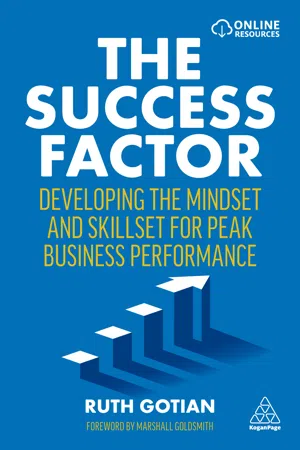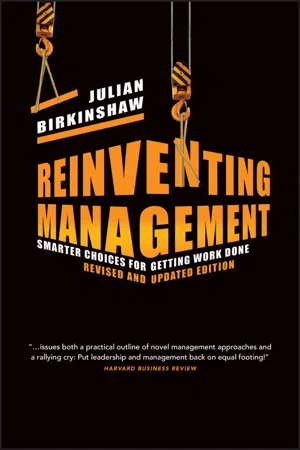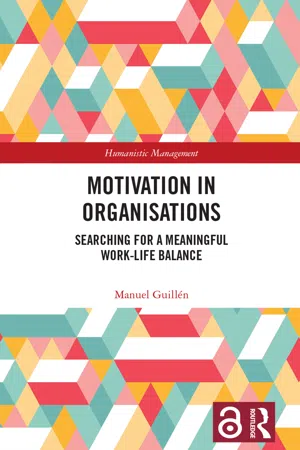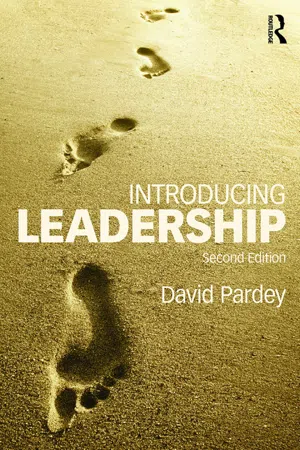Business
Intrinsic Motivation
Intrinsic motivation refers to the internal drive and satisfaction that individuals experience when engaging in an activity for its own sake, rather than for external rewards or pressures. In a business context, fostering intrinsic motivation can lead to higher job satisfaction, creativity, and productivity among employees, as they are driven by personal fulfillment and enjoyment in their work.
Written by Perlego with AI-assistance
Related key terms
Related key terms
1 of 4
Related key terms
1 of 3
12 Key excerpts on "Intrinsic Motivation"
- Colin P. Silverthorne(Author)
- 2005(Publication Date)
- NYU Press(Publisher)
Some people seem to be driven by a passionate interest in their work, a deeper level of enjoyment and involvement in what they do, while others seem to be motivated more by external inducements to work. Intrinsic Motivation can be considered the “labor of love” aspect driving human behavior, which comes from inside the individual, based on their individual interests and involvement in work. This type of motivation occurs when individuals engage in work primarily for its own sake, because the work is engaging or in some ways satisfying. On the other hand, extrinsic motivation is to work primarily in response to something apart from the work itself, such as a reward, recognition, or the dictates of other people. Extrinsic motivation is thus based on the goal of achieving something other than the work itself (Amabile, 1997). The majority of research on work motivation has focused on intrinsic rather than extrinsic motivation.Although the extrinsic-intrinsic dichotomy of rewards has been well established and accepted in the field of organizational psychology, there are still some major issues to be considered. The classification of types of reward is based on definitions and constructs that are difficult to establish consistently. Further, various researchers have used different definitions of intrinsic and extrinsic motivation, making comparison of the research findings difficult. For example, some researchers define an intrinsic reward as one that is self-administered and an extrinsic reward as one that comes from others (Kanungo and Hartwick, 1987).Contemporary views of Intrinsic Motivation include both cognitive (thoughts and judgment) and affective (emotions or feelings) components. For example, cognitive-evaluation theory argues that self-determination and competence are the hallmarks of Intrinsic Motivation (Deci and Ryan, 1985). Intrinsic Motivation has also been defined as the experience of gaining enjoyment from performing a work task without the performance being controlled by external contingencies (Thomas and Velthouse, 1990). The researchers who formulated this definition suggest that there are four dimensions of assessment or judgment that individuals use to evaluate their work environment and that these are part of the cognitive component of Intrinsic Motivation. These four dimensions are impact, competence, meaningfulness, and choice. Most employees will experience job satisfaction when given moderate challenges on the job, since individuals tend to prefer jobs that give them the opportunity to undertake mentally challenging work. Jobs that have too little challenge result in boredom, while jobs with too much challenge can lead to frustration, stress, and feelings of failure (Katzell, Thompson, and Guzzo, 1992). Affective components of Intrinsic Motivation include interest and excitement (Izzard, 1977), elation and the flow of deep task involvement (Csikszentmihalyi, 1997), or happiness and surprise (Reeve, Cole, and Olsen, 1986). Extrinsic rewards have been considered to be primarily cognitive in nature (Lepper and Greene, 1978).- eBook - ePub
The Success Factor
Developing the Mindset and Skillset for Peak Business Performance
- Ruth Gotian(Author)
- 2022(Publication Date)
- Kogan Page(Publisher)
others judge you. You might be extrinsically motivated to get the respect and admiration of others, so ultimately, others control the rewards and therefore govern us. I find that those who are driven by extrinsic motivation tend to burn out or fail out. Their goal is simply to finish, and they often aim for average.Intrinsic Motivation means your drive for doing something comes from internal sources such as your core values, interest, morals, and passion. You find it enjoyable and inherently interesting. It results in high-quality work and creativity. When intrinsically motivated, you find joy and challenge in your pursuit and are liberated from the pressure resulting from external measures such as awards.When you have identified your Intrinsic Motivation, it becomes a source of burning passion. It becomes your reason for waking up in the morning and why you will burn the midnight oil as you consistently push yourself to do more. You know you are passionate about what you do when you are so motivated that you would do it for free if you could. Time stands still, and you are in a state of flow. You are completely mesmerized by your work. You do not notice the minutes and hours ticking by. You do not have hunger pain, you are not stiff yet, you feel no pain, you are entirely in the zone. You are intrinsically motivated to succeed.Motivation gives you focus and energy and drives your perseverance. In adult learning and social psychology, we use social determination theory (SDT) to examine motivation and what it would take for it to be realized. Edward Deci and Richard Ryan, who came up with SDT, state that to be genuinely intrinsically motivated, you need to satisfy your need for competence, autonomy, and relatedness (Deci et al, 2001; Deci and Ryan, 1985, 2000; Ryan and Deci, 2000).Selecting what you are good at
Competence refers to having the ability to succeed and excel at what we do. It would be hard to be motivated to do something you were not good at, let alone something you did not master. All Olympic athletes referenced their natural talent and ability to compete at a higher level than their peers. The scientists mentioned that they were good at science, and the concepts made sense to them. If you watched The Queen’s Gambit - Claire Valentin(Author)
- 2017(Publication Date)
- CIPD - Kogan Page(Publisher)
needs (drives) that have to be addressed. Motivation theory can help us understand what supports engagement in learning and what inhibits it.One key debate is whether motivation is intrinsic or extrinsic . Intrinsic Motivation comes from within the individual, who experiences an inherent satisfaction from a particular activity; for example, if we feel cold we are driven to put on a sweater. Extrinsic motivation is motivation to perform an activity in order to attain some separable outcome (Porter et al 2003). For example, we may go on a course in order to obtain a qualification – we may be mainly motivated by the promise of what we will gain through obtaining the qualification, rather than the intrinsic satisfaction of the new knowledge that we will learn.Intrinsic Motivation moves individuals to take on challenges or seek out new experiences. Extrinsic motivation can be positive – for example an inspirational leader can inspire motivation (Northouse 2007), or coercive, such as threats and punishment; individuals differ in how they respond to these pressures.Passage contains an image
Case Study 3.1 Standard Chartered BankThe Bank’s 9000 managers are supported through the Great Managers Programme which includes a mix of training and online tools and communications which equip them to bring the Standard Chartered story to life for their team members … As a result, staff are better focused, motivated and engaged, which is reflected in business outcomes – lower levels of staff turnover, and improved financial performance.Adapted from Macleod And Clarke (2009, P86)Review of motivation theory
A number of early theorists still have a significant impact on thinking and provide the basis for more recent thinking. We will now explore some of the key ideas from motivation theories that have been influential in business and psychology.- Christine M. Rubie-Davies, Jason M. Stephens, Penelope Watson, Christine M. Rubie-Davies, Jason M. Stephens, Penelope Watson(Authors)
- 2015(Publication Date)
- Routledge(Publisher)
Intrinsic Motivation arises from within an individual, and relates to activities that are experienced as valuable and interesting in their own right. For example, a student may spend time reading about situational moderators of gene expression because they are intellectually drawn to the topic and wish to explore it, independent of whether that reading was associated with any formal learning task. Intrinsic Motivation is an innately valuable human state, but also has educational relevance – being associated with deeper learning, better performance, and greater persistence by students (Reeve et al. 2008). Deci and Ryan’s work has established that Intrinsic Motivation requires two factors to flourish: a sense of autonomy, of being able to choose how one will think and act; and competence, the ability to follow through on what one wishes to do. Without one or both of these conditions, Intrinsic Motivation diminishes or disappears completely. As learning is inherently related to motivation, autonomy and competence can therefore be seen as learning needs, as well as motivational ones. One effect worth noting here is that external rewards have been repeatedly found to decrease, rather than increase, Intrinsic Motivation (e.g. Deci et al. 1999). This effect is most substantial when the reward is contingent on task completion (associated with a decreased sense of autonomy and competence) or performance (associated with a decreased sense of autonomy). In addition, while lowered levels of autonomy signal a shift to more externally controlled motivation, a sufficiently lowered sense of competence is able to elicit amotivation, where individuals are not motivated to perform the task at all. This has important implications for those seeking to motivate students, or for teachers who wish to encourage individuals in what is intrinsically interesting to them. In contrast to an internal impetus, extrinsically motivated actions arise from external, second-order considerations- eBook - ePub
- Michael Hymans(Author)
- 2022(Publication Date)
- Routledge(Publisher)
Motivation is the internal condition that activates behaviour and gives it direction. Motivation energises and directs goal-oriented behaviour. The term is generally used for human motivation but, theoretically, it can be used to describe the causes for animal behaviour as well. According to various theories, motivation may be rooted in the basic need to minimise physical pain and maximise pleasure; or it may include specific needs such as eating and resting; or a desired object, hobby, goal, state of being, ideal; or it may be attributed to less-apparent reasons such as altruism, morality or avoiding mortality.Motivation Concepts: Intrinsic and Extrinsic Motivation
Intrinsic Motivation refers to motivation that comes from inside an individual rather than from any external or outside rewards, such as money or good grades. The motivation comes from the pleasure one gets from the task itself or from a sense of satisfaction in completing or even working on a task. An intrinsically motivated person will work on a mathematical equation, for example, because it is enjoyable. Or an intrinsically motivated person will work on a solution to a problem because the challenge of finding a solution provides a sense of pleasure. In neither case does the person work on the task because there is some reward involved, such as a prize, a payment, or in the case of students, a high grade. Intrinsic Motivation does not mean, however, that a person will not seek rewards. It just means that such external rewards are not enough to keep a person motivated. An intrinsically motivated student, for example, may want to get a good grade on an assignment, but if the assignment does not interest that student, the possibility of a good grade is not enough to maintain that student’s motivation to put any effort into the project.This form of motivation has been studied by social and educational psychologists since the early 1970s. Research has found that it is usually associated with high educational achievement and enjoyment by students. Intrinsic Motivation has been explained by Heider’s (1958 ) attribution theory, Bandura’s (1986 , 1993 and 1997 ) work on self-efficacy and Deci and Ryan’s (1985 - eBook - ePub
Reinventing Management
Smarter Choices for Getting Work Done, Revised and Updated Edition
- Julian Birkinshaw(Author)
- 2012(Publication Date)
- Jossey-Bass(Publisher)
5 In the context of business, it is what drives an individual to spend time and energy on a particular task or goal. It is obvious, when you look at the people who work for you, that motivation levels vary from person to person, and from job to job. So to understand why this is the case, researchers have taken two approaches: some have focused on employees’ underlying needs and wants, while others have focused on the drivers that stimulate people to work harder.One key insight that has emerged from this research is distinction between intrinsic and extrinsic motivation. Intrinsic Motivation comes from the rewards inherent to a task or activity itself—for example, playing the piano, walking in the countryside, or solving a puzzle. Extrinsic motivation comes from outside the person—money is the most obvious example, but coercion and the threat of punishment are also common extrinsic motivators.6 Recent research by psychologists Edward Deci and Richard Ryan has extended this thinking in a couple of useful directions.7 One is a better understanding of the components of Intrinsic Motivation—the need for competence, the need for autonomy, and the need for relatedness to others. The other is the identification of a hybrid third type of motivation they labeled internalized extrinsic motivation . For example, when employees receive promotions, or recognition from their peers, these are externally granted but they are internalized as valuable by the individual, and therefore they become intrinsic. The extrinsic–intrinsic dichotomy, in other words, is really a sliding scale with various levels of internalized motivators between the two end-points.MIT Professor Douglas McGregor’s well-known distinction between Theory X and Theory Y is also highly relevant here.8 - eBook - ePub
Reinventing Management
Smarter Choices for Getting Work Done
- Julian Birkinshaw(Author)
- 2010(Publication Date)
- Jossey-Bass(Publisher)
It is obvious, when you look at the people who work for you, that motivation levels vary from person to person, and from job to job. So to understand why this is the case, researchers have taken two approaches: some have focused on employees’ underlying needs and wants, while others have focused on the drivers that stimulate people to work harder. One key insight that has emerged from this research is distinction between intrinsic and extrinsic motivation. Intrinsic Motivation comes from the rewards inherent to a task or activity itself—for example, playing the piano, walking in the countryside, or solving a puzzle. Extrinsic motivation comes from outside the person—money is the most obvious example, but coercion and the threat of punishment are also common extrinsic motivators. 6 Recent research by psychologists Edward Deci and Richard Ryan has extended this thinking in a couple of useful directions. 7 One is a better understanding of the components of Intrinsic Motivation—the need for competence, the need for autonomy, and the need for relatedness to others. The other is the identification of a hybrid third type of motivation they labeled internalized extrinsic motivation. For example, when employees receive promotions, or recognition from their peers, these are externally granted but they are internalized as valuable by the individual, and therefore they become intrinsic. The extrinsic-intrinsic dichotomy, in other words, is really a sliding scale with various levels of internalized motivators between the two end-points. MIT Professor Douglas McGregor’s well-known distinction between Theory X and Theory Y is also highly relevant here. 8 McGregor was concerned with understanding how managers shaped the behavior of their subordinates. Theory X represented a belief that workers are inherently lazy and require extrinsic rewards to get their work done; Theory Y viewed workers as self-motivated, ambitious, and intrinsically motivated - eBook - ePub
Motivational Psychology of Human Development
Developing Motivation and Motivating Development
- J. Heckhausen(Author)
- 2000(Publication Date)
- North Holland(Publisher)
While there is empirical evidence as discussed above for Intrinsic Motivation, there are conceptual problems and paradoxes that make it difficult to apply Intrinsic Motivation concepts at work. We think that there are three major problems.First, at work, one usually gets to do tasks. These tasks are most of the time externally given and not self-developed. Therefore, one cannot speak of work being “done freely” as required in definitions of Intrinsic Motivation.Second, as in most applied settings, on the job behavior is affected by a multitude of factors. Some of these are external rewards (e.g., money) and some of them are internal (e.g., interest in a certain type of task). However, one very important motivator at work is probably money. People expect (and usually obtain) a monetary reward. Withholding the salary would reduce the behavior to zero (people usually do not come to work if they are not paid). This would occur even if someone enjoyed her job very much. Many other extrinsic rewards are involved in work, for example, receiving approval from a supervisor or colleagues, getting a promotion, or exerting power over people.According to the Intrinsic Motivation literature, the overjustification effect implies that there is a reciprocal relationship between internal and external rewards. The more one gets extrinsic regards, the smaller is the Intrinsic Motivation. Therefore, the ubiquitous presence of extrinsic motivators in the domain of work excludes the possibility of work behavior being truly intrinsically motivated.Third, the hallmark of Intrinsic Motivation is the experience of positive feelings such as enjoyment, satisfaction, and pleasure. Using Intrinsic Motivation as a framework to understand self-starting behavior at work requires self-starting behaviors to be accompanied by positive emotions and positive affect. This is untenable. There are some, albeit small, positive relationships between positive emotions at work (i.e., job satisfaction) and work behavior (i.e., performance) (Iaffaldano & Muchinsky, 1985 - eBook - ePub
Motivation in Organisations
Searching for a Meaningful Work-Life Balance
- Manuel Guillen(Author)
- 2020(Publication Date)
- Routledge(Publisher)
They are among the strongest and most omnipresent drivers of human behaviour because they relate to our creative capacity, the joy of discovery and the delight in mastering challenges. Their “reward” is the activity itself, performing to the best of one’s ability, and not the external aspects of the work. Therefore, one thing we all should attempt to do is (2) “fall in love” with our own work, or at least with those aspects of our work that are more attractive for us (Pink, 2009). We should (3) look at every activity in our daily work (any kind of work) as an opportunity for growth and, whenever possible, the joy in learning. We need to keep in mind that those people with higher Intrinsic Motivations of self-esteem and sense of autonomy also tend to have better interpersonal relationships and a greater general well-being than those who are just extrinsically motivated. This does not necessarily depend on the nature of the task performed, as we will discuss later in Chapter 8. Furthermore, intrinsically motivated people usually achieve more than their reward-seeking counterparts because extrinsic motivations can give us less of what we actually desire. In fact, they can extinguish Intrinsic Motivation, diminish performance and crush creativity, fostering short-term thinking. Too little Intrinsic Motivation would mean a lack of passion and interest in our work and lives, whereas too much, at the expense of forgetting extrinsic needs, would probably also be a mistake. We all need to (4) satisfy our basic and social external needs (Pink, 2009). However, it does not mean that extrinsic motivations, those related to rewards and punishments – or “carrots and sticks” as some authors call them – are entirely reasonable. According to Herzberg, they have to be fulfilled in order to avoid dissatisfaction - Des Hewitt, Brittany Wright(Authors)
- 2018(Publication Date)
- SAGE Publications Ltd(Publisher)
As an individual, we may experience a sense of challenge differently from another person. What is intrinsically motivating for one person may not be for another. It is true to say as well that levels of Intrinsic Motivation may rise or fall over a period of time. Just because something is intrinsically motivating for you as a child is no guarantee that you will have the same Intrinsic Motivation later in on life. It is also quite logical that someone can be both intrinsically motivated and extrinsically motivated for an activity. For instance, a pupil in school may love reading Charles Dickens as an activity in itself, whilst also aspiring to achieve a high grade at the end of year exam in English because this will allow them to pass to the next stage of the school system at the age of 16 years. Learners can have different things they are interested in. We can have an interest in an activity like reading, but this is no guarantee that it is intrinsically motivating in itself. Logically, but unlikely, is the possibility that someone may be intrinsically motivated but have no interest in something. It is possible, for instance, that someone may be motivated to sit exams without having an interest in exams. It is, however, counter-intuitive. Bound up in the concept of Intrinsic Motivation is the idea of ‘interest’. Zimmerman and Schunk (2008) define this as how much someone likes or is engaged in an activity. Interest can be looked at in different ways. Broadly, we can categorise this in two main ways – internal or personal and external or situational forms of interest: Internal or personal interest is our liking for certain topics, pursuits or areas of learning. A child might love learning about dinosaurs. One teacher recounts the tale of a 6-year-old pupil she taught. They did a simple project on fossils. His mum later said that he was so interested in this topic, that it became a lifelong interest- eBook - ePub
Sustaining Workforce Engagement
How to Ensure Your Employees Are Healthy, Happy, and Productive
- Lonnie Wilson(Author)
- 2019(Publication Date)
- Productivity Press(Publisher)
In general, there are two types of motivation: extrinsic and intrinsic. Extrinsic motivators come from “an external locus of causality”, that is, from outside of the individual. Examples are money, awards, prestige, power and social position, which all come from someone else or somewhere else.Intrinsic motivators, on the other hand, are those that arise from within the individual. These include doing things for the pure joy of doing them. They are the motivators which cause people to take up hobbies, work for volunteer organizations and, for our purpose, the motivators which cause a natural enjoyment at work.Maslow on motivation – His hierarchy of needs The theoryIn his classic book Motivation and Personality (1954), Abraham Maslow described a multi-level theory of human motivation (Figure 11.1 ). In it, he stated:Figure 11.1 Maslow’s hierarchy of needs. (From www.simplepsychology.com )■ To be motivated is to be driven (to act upon), to satisfy a need. ■ Until the needs, at that level, were satisfied, those needs would push all other needs to the background. ■ However, once that specific need was satisfied, it was no longer a motivating factor and the needs of the next level would be the “driver of interest” to the person. ■ There was a natural progression up the hierarchy, and although there was some regression and return, the overall lifelong process of the individual was to ascend the hierarchy. ■ Maslow said “man is a wanting animal and is never satisfied for very long”, and ■ “Humans are never satisfied, except in a one-step-along-the-way fashion and the wants arrange themselves in some sort of a hierarchy” ■ There were five levels to his hierarchy of needs. Starting from the most basic, they were: a. The physiological needs of food, water, shelter; often called the survival needs b. The safety needs of protection, security and freedom from danger. i. Levels one and two, taken together are called “the basic needs”. c. The belongingness needs including friends, relationships and intimacy. d. The esteem, or ego, needs of prestige and a sense of accomplishment. - eBook - ePub
- David Pardey(Author)
- 2016(Publication Date)
- Routledge(Publisher)
internal perceived locus of causality, that is, that you feel in control and responsible for what you are doing.■ OIT is concerned with the level of regulation and reflects the level of autonomy (personal control) that you experience, and the degree to which this is fully aligned with your own perceptions or beliefs about what should be done. Ryan and Deci propose different states of this alignment, from being externally regulated (lacking any real personal control), through introjected regulation (reluctantly accepting it, at least in part, to demonstrate some self-worth), then regulation through identification (consciously valuing a regulation so that it is seen as being of personal value) to integrated regulation (where the regulation is fully assimilated so that it is aligned with your sense of self-worth – in this state, the extrinsic motivation is fully aligned with the Intrinsic Motivation).Although SDT is presented differently from other theories, the same phenomena appear – the emphasis on personal fulfilment and relationships is a common factor. Ryan and Deci argue that Intrinsic Motivation, being inherent in people, isn’t caused by others but that what other people do can facilitate or undermine it. Rewards or feedback that make people feel competent, and task design that makes people feel in control of their work and that provides opportunities for people to work in positive relationships with others, will enhance their Intrinsic Motivation. Extrinsic motivation that seeks to regulate someone’s behaviour by rewards (or punishment) can affect a person’s sense of autonomy positively or negatively, depending on the extent to which they identify with the objectives of the regulation.I’ve already mentioned that there was one small subgroup of (mainly) men who rated a bonus system as the dominant motivator in ILM’s ‘Beyond the Bonus’ research. They also didn’t see job enjoyment or relationships with others as at all important to them – they had (according to SDT) internalised the regulating effect of a bonus system (since it is designed to control behaviour) and so felt that it aligned with their own perceptions and beliefs. Consequently, for them it was a very positive extrinsic motivator; however, they were a fairly small minority in the sample!
Index pages curate the most relevant extracts from our library of academic textbooks. They’ve been created using an in-house natural language model (NLM), each adding context and meaning to key research topics.
Explore more topic indexes
Explore more topic indexes
1 of 6
Explore more topic indexes
1 of 4











